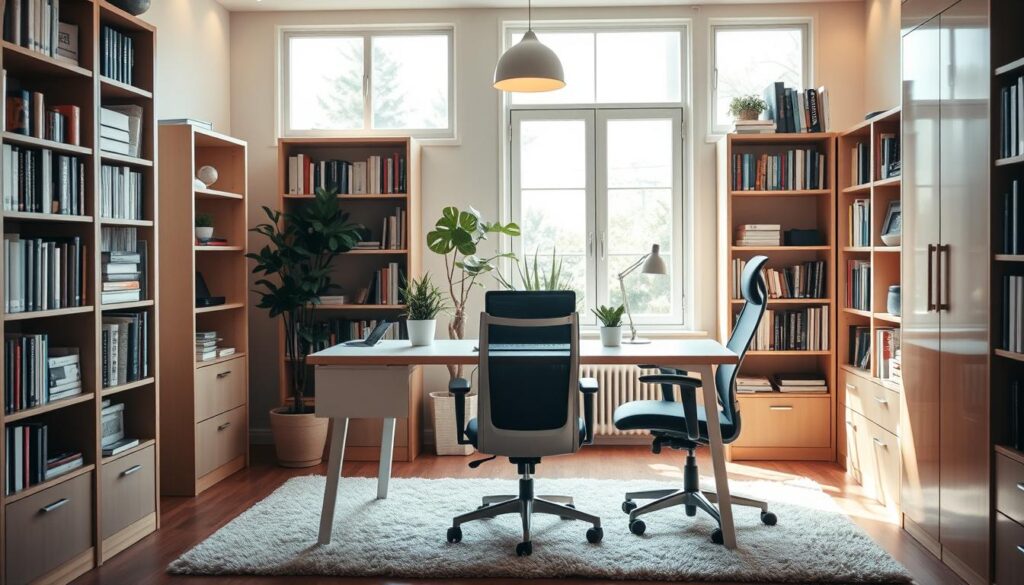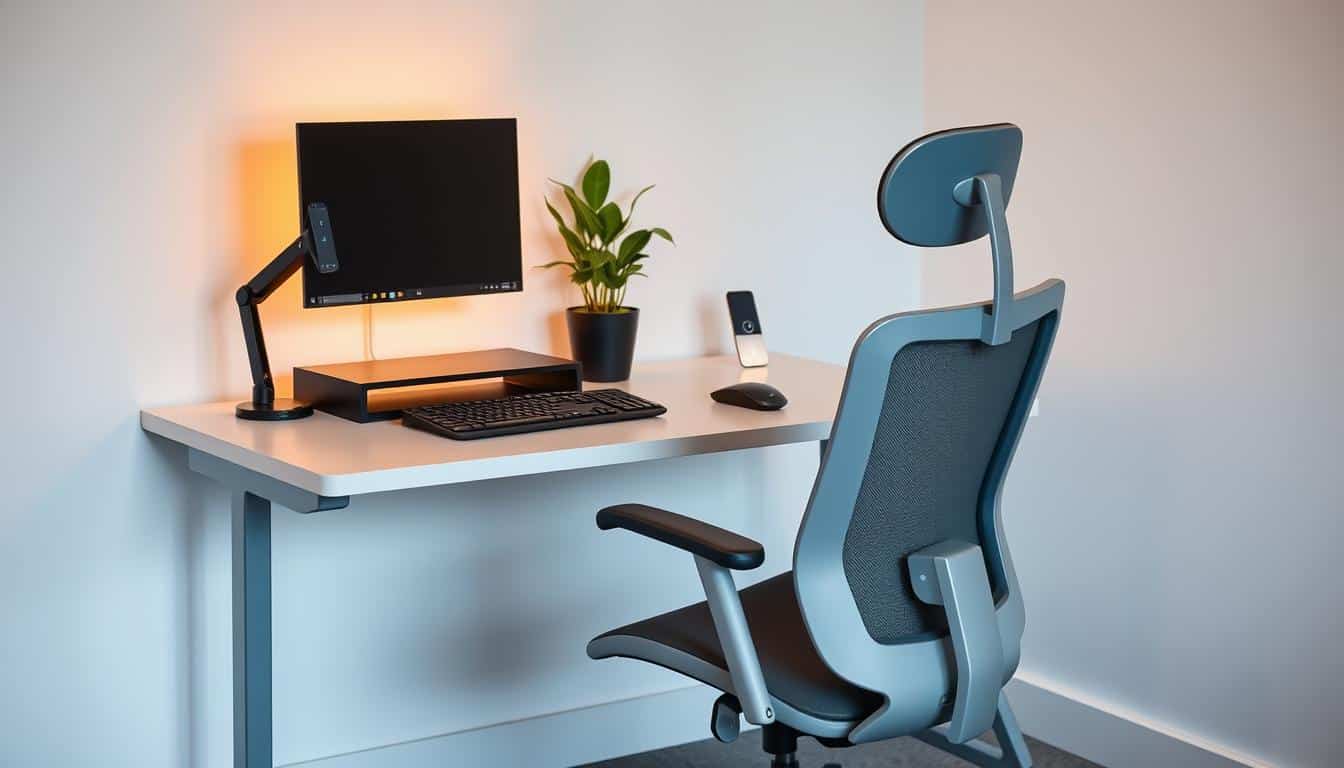In today’s world, lots of people work from home. Yet, making a good workspace at home can be tough without a separate office area. This article will give useful advice for boosting productivity and setting up a good work spot, even with little space. We’ll look into what you need, furniture choices, and tech needs to make working from home work well for you.
Understanding the Need for a Dedicated Workspace
Having a dedicated workspace boosts productivity when you work remotely. Moving work from the kitchen table or couch to a specific area helps focus. This change makes tasks easier to do and improves concentration. A special workspace also sets limits, helping to balance work and life better, which is often tough in remote work.
Remote work comes with its own set of challenges, like distractions and mixing up work with home life. Creating a workspace just for work helps handle these issues. It makes it easier to focus on your job without home life getting in the way. Taking the time to set up a workspace helps remote workers do well, keeping them productive and helping maintain a good work-life balance.

Essentials for a Productive Remote Work Setup
Setting up a productive remote work space needs you to think about key items. These items, like tools and tech, help keep you focused. They make sure you can perform well while working from home. Getting the right gear and tools is a big step towards working more efficiently from home.
Key Tools You Should Have
At the top of your list should be a dependable computer. You’ll also need:
- An ergonomic chair to support long hours of work
- A sturdy desk that accommodates your computer setup
- A quality webcam for seamless virtual meetings
- A clear-sounding headset to facilitate communication
These parts of your home office help create a place that’s both comfortable and efficient. With the right tools, you can focus on your work without getting sidetracked.
Importance of High-Speed Internet
A stable internet is crucial for good remote work. Fast internet matters a lot for video calls and working with others in real-time. Using cables for your network might work better than Wi-Fi. A good internet connection means better call quality, which helps with talking and getting things done.
Choosing the Right Location in Your Home
Looking for the perfect spot in your house for work is key to doing well in remote jobs. The setting can change how you feel and how well you focus. Adding things like sunlight can make your work area nicer. Picking a place that combines light, comfort, and few distractions helps you be more productive.
Maximizing Natural Light
Natural light keeps your energy up all day. If you set up your work area near windows, sunlight comes in. This makes you more alert and feel better overall. Research shows that sunlight can make you happier and less tired. Good lighting, with big windows or mirrors in the right spots, makes a space feel open. This helps you think better and be more creative.
Avoiding Distractions for Better Focus
Even though sunlight is good, distractions are bad for work. Pick a work area where it’s not noisy and you won’t be interrupted. You can hang curtains or blinds to keep out distractions but let in light. Making your work area less distracting means you can focus more. This lets you get your work done better and faster.
Furniture Choices for a Small Space
Choosing the right furniture for a small office is very important. Ergonomic furniture not only increases comfort but also helps you work better. Adjustable desks let you sit or stand, helping avoid the pains from sitting too long. Also, picking chairs with good lower back support is key to prevent strain after hours of work.
Recommendations for Ergonomic Desks and Chairs
Here are some desk and chair suggestions for better comfort and function:
- Vari Electric Standing Desk – This adjustable desk lets you change heights, perfect for sitting or standing.
- Herman Miller Aeron Chair – Offers excellent lumbar support and fits different body types for comfort all day.
- Flexispot E5 Sit-Stand Desk – Has a strong build and changeable height settings, great for long hours in a small space.
- Steelcase Leap Chair – Comes with an adjustable back and seat depth for top ergonomic support during work.
Creative Storage Solutions to Save Space
Smart storage is key for keeping a small office neat. Try these ideas to improve your space:
- Go for vertical shelving to use wall space well.
- Pick desks with drawers for built-in storage.
- Try under-desk storage bins to keep things handy yet out of the way.
- Use pegboards for organizing tools and supplies. It’s a smart way to save space and stay organized.
Optimize Remote Work Setup with No Office Space
Making a remote work spot productive often depends on smart space use. This is key in homes without special office areas. Putting things up on walls can really help if you’re tight on room. It makes your work area tidy and helps you stay focused and do better work.
Incorporating Vertical Space for Efficiency
Want to make your home workspace better? Think about these tips:
- Install wall shelves to store books, supplies, and decorative items.
- Use pegboards for easy access to tools and notes, freeing up desk space.
- Utilize over-the-door organizers for storing office supplies and stationery.
Using space well, especially vertical storage, is a big deal for a good work area at home. By keeping things off your desk and neatly up high, your space stays looking nice. A tidy space means fewer distractions when you’re getting work done from home.
Ambiance and Lighting Considerations
Choosing the right ambiance and lighting is crucial for a great workspace. It makes the area comfy, affecting how you feel and work. The right light can lessen eye strain and help you concentrate better. This can lead to more creativity and sharp thinking all day.
Importance of Proper Ambient Lighting
Ambient lighting is key for a productive work area. It helps to spread light evenly, cutting down on screen glare and increasing comfort. Benefits of good ambient lighting include:
- Lowering the discomfort from strong lighting.
- Making a peaceful environment that helps you stay focused.
- Helps in achieving a good balance between work and relaxation time.
Using Plants to Improve Mood and Productivity
Adding plants to your workspace does more than just look nice. They can make you feel happier and more creative while lowering stress. Here’s how to include plants in your space:
- Pick plants that are easy to take care of, like succulents or snake plants.
- Keep them close to your work area for convenience.
- Use different plant holder styles to fit your workspace look.
Technical Setup for Remote Work
Setting up the right tech is key for good remote work. Having the best gear makes work smoother and less stressful. You’ll need a dependable computer, a big screen, and other tools that fit your work style.
Essential Equipment: Laptops, Monitors, and Peripherals
Choosing the right tools for working from home matters a lot. Here’s what to think about:
- A reliable laptop or desktop keeps things running smoothly, even with many tasks.
- Monitors give you more room to work, making it easier to handle documents and apps.
- Good keyboards and mice make long work hours more comfortable.
Troubleshooting Common Technical Issues
Even the best setups can have problems. Knowing about common issues helps fix them faster. Look out for:
- Internet troubles – First, check your router and modem.
- Software bugs – Stay up to date with updates to avoid problems.
- Issues with accessories – Make sure they’re all connected right.
Creating a Minimalist Home Office
A minimalist workspace helps you work better by cutting down on things that can distract you. Having a space that is free from clutter makes it easier to think clearly, which is very important when you’re working from home. By following some simple steps, you can make your workspace a place where organization and focus come naturally.
Benefits of a Clutter-Free Environment
Having a space that’s free of clutter is not only nice to look at but it also makes you feel better mentally, helping you get more work done. Here are some benefits:
- Improved focus due to reduced visual distractions.
- Increased creativity and better problem-solving abilities.
- Lower stress levels resulting from organized spaces.
How to Use Multi-Functional Furniture
Choosing furniture that serves more than one purpose is a smart move for a minimalist workspace. Look for pieces that offer both style and function. Here are some ideas:
- Choose desks with built-in storage to minimize clutter.
- Utilize ottomans that double as storage for office supplies.
- Invest in foldable chairs that can be easily tucked away when not in use.
Prioritizing Comfort and Health
Making your workspace ergonomic boosts health and comfort, especially during long work days. Designing for proper ergonomics prevents injuries from repetitive actions. Correct chair and desk height keep wrists straight, helping avoid issues like carpal tunnel syndrome. By focusing on ergonomics, you not only increase comfort but also encourage healthier working habits for better well-being.
Ergonomics and Preventing Strain Injuries
If you work from home, ergonomics is key to preventing pain. A good chair, desk, and equipment set-up can lower injury risk. Here are tips to consider:
- Choose a chair that provides lumbar support and encourages good posture.
- Adjust your monitor height to eye level to prevent neck strain.
- Use an ergonomic keyboard and mouse to reduce wrist strain.
Maintaining Good Posture While Working
Keeping proper posture is crucial for your health and comfort at work. A few adjustments can significantly improve your posture:
- Keep your feet flat on the floor or on a footrest.
- Ensure your back is fully supported against the chair.
- Position your elbows at a 90-degree angle while typing.
Utilizing Noise-Canceling Equipment
Today’s remote work scene is full of distractions. Noise-canceling headphones are key to boosting focus. They block out background noise, creating an ideal space for work.
Choosing the Right Headphones for Focus
When picking noise-canceling headphones, the right choice can change your work from home audio experience. Here are some tips:
- Comfort and Fit: Choose headphones that feel comfortable for prolonged use. Look for adjustable headbands and cushioned ear cups.
- Sound Quality: High-quality audio enhances the listening experience, making it easier to remain engaged during work tasks.
- Battery Life: Opt for headphones with long battery life, ensuring they last through long work hours.
- Portability: Compact and lightweight models are easier to carry, supporting flexibility in your workspace decision.
Noise-canceling headphones help you focus better and enjoy music deeply in any situation. The perfect pair turns your home into a productive space.
Combining Work and Leisure Space
Nowadays, having a space for both work and play is key for many people. When space is limited, making a home office that is also a cozy spot for relaxation is smart. This helps in mixing work life with personal life smoothly.
Creating clear zones in a room is vital for staying focused while working. Using furniture that changes for different needs, like desks that fold or seats that rearrange, is helpful. These pieces can clearly separate work areas from places to relax. This separation boosts productivity and is good for mental health by marking off work time from chill time.
Adding things like soft lights, plants, and comfy chairs can make a work area also a place to unwind. Making a spot feel cozy is important for moving easily from work mode to relaxation mode. Using decor like screens or bookcases to split the space can make dual-purpose areas work better.
How to Keep Work and Home Life Separate
Keeping work and personal life apart is key for balance. Setting specific work times boosts focus and stops burnout. By making a schedule and sticking to it, you can set a routine that helps concentrate during work.
Using room dividers or special work areas helps keep things separate. These visual tips remind you when it’s work time, making it easier to relax later. Ending the work day with a ritual helps keep work and play time balanced. Actions like turning off your computer help signal it’s time to unwind.
Following these tips not only improves focus but also ensures your free time is for fun. By keeping work and life separate, you can manage your duties better. This leads to feeling happier at work and at home.
Conclusion
Working from home can be great with good planning and the right tools. Choosing the best furniture, lighting, and equipment helps a lot. Important steps like keeping things organized and reducing noise make a home office work well.
Getting your home office right means paying attention to how comfortable and functional it is. Using space wisely and making sure everything is comfy is key. This helps keep a balance between work and personal life, which boosts productivity.
To really make your home workspace great, keep checking and changing things as needed. Trying new tech and furniture can make a big difference. Follow these tips and your home work life will get better, with more success and happiness.



